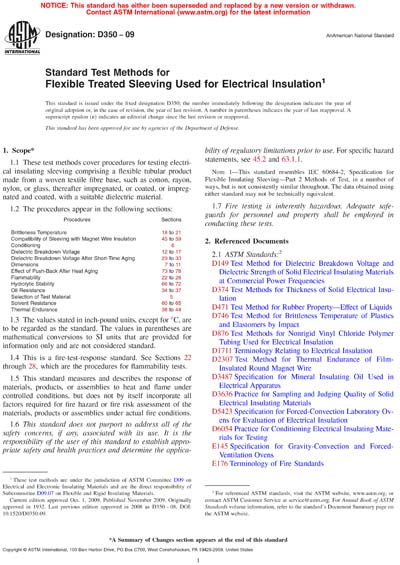Historical
ASTM D350-09
Standard Test Methods for Flexible Treated Sleeving Used for Electrical Insulation
1.1 These test methods cover procedures for testing electrical insulating sleeving comprising a flexible tubular product made from a woven textile fibre base, such as cotton, rayon, nylon, or glass, thereafter impregnated, or coated, or impregnated and coated, with a suitable dielectric material.
1.2 The procedures appear in the following sections:
| Procedures | Sections |
| Brittleness Temperature | 18 to 21 |
| Compatibility of Sleeving with Magnet Wire Insulation | 45 to 59 |
| Conditioning | 6 |
| Dielectric Breakdown Voltage | 12 to 17 |
| Dielectric Breakdown Voltage After Short-Time Aging | 29 to 33 |
| Dimensions | 7 to 11 |
| Effect of Push-Back After Heat Aging | 73 to 78 |
| Flammability | 22 to 28 |
| Hydrolytic Stability | 66 to 72 |
| Oil Resistance | 34 to 37 |
| Selection of Test Material | 5 |
| Solvent Resistance | 60 to 65 |
| Thermal Endurance | 38 to 44 |
1.3 The values stated in inch-pound units, except for °C, are to be regarded as the standard. The values in parentheses are mathematical conversions to SI units that are provided for information only and are not considered standard.
1.4 This is a fire-test-response standard. See Sections 22 through 28, which are the procedures for flammability tests.
1.5 This standard measures and describes the response of materials, products, or assemblies to heat and flame under controlled conditions, but does not by itself incorporate all factors required for fire hazard or fire risk assessment of the materials, products or assemblies under actual fire conditions.
1.6 This standard does not purport to address all of the safety concerns, if any, associated with its use. It is the responsibility of the user of this standard to establish appropriate safety and health practices and determine the applicability of regulatory limitations prior to use. For specific hazard statements, see 45.2 and 63.1.1.
Note 1—This standard resembles IEC 60684-2, Specification for Flexible Insulating Sleeving—Part 2 Methods of Test, in a number of ways, but is not consistently similar throughout. The data obtained using either standard may not be technically equivalent.
1.7 Fire testing is inherently hazardous. Adequate safeguards for personnel and property shall be employed in conducting these tests.
45.1 These test methods evaluate the degrading effects, if any, of sleeving on magnet wire insulation.
45.2 Warning—These procedures include the hazardous operation of the use of glass test tubes in a heated oven.
66.1 This procedure evaluates the permanent effects of prolonged exposure to moisture at elevated temperatures by means of a visual and electrical test. It is limited to sizes of sleeving that can be conveniently conditioned in test tubes (about size 0 maximum). It is possible to evaluate larger sizes if chambers capable of maintaining the prescribed exposure conditions are available.
73.1 While possibly applicable to other types of sleeving of an elastomeric nature, this test method applies principally to silicone elastomer sleeving.
Content Provider
ASTM International [astm]






